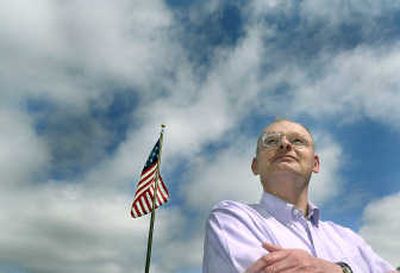Area residents join weather-reporting program

Richard Keene definitely knows his anemometer from his barometer. One measures wind, the other air pressure.
Duane Becker knows weather sensors, too, but from his south-facing home, he can see distant storms approaching the region.
Both Spokane-area residents are new volunteers in a nationwide weather reporting program brought to Washington state just this month – the Community Collaborative Rain, Hail and Snow Network, known by the acronym “CoCoRaHS.”
Keene, Becker and other volunteers use the Web to provide daily reports on precipitation at their homes, which gives forecasters a better idea of how storms affect the region. They also are supposed to submit ground reports when severe weather strikes, such as a damaging hail and thunderstorm that struck Spokane County on June 11.
“More observation points will give a more complete picture of the climate and what’s going on,” explained Keene, who was captivated by weather as a small child and is still fascinated “by all of the variables that are interacting with each other to make the whole.”
Walking into his home in southeast Spokane is like entering a weather station. He has eight barometers, most of them mounted on the wall next to his front door, numerous temperature sensors and recording devices.
By joining CoCoRaHS, Keene said he will be able to share his passion with the public.
Becker lives on a mountainside northeast of Elk in a spot that gives a wide-angle view toward the south and west. He can see storms as they arrive in Spokane. He was already signed up to be a spotter for the weather service, an older system in which volunteers telephone severe weather reports directly to the Weather Service. He, too, has been interested in weather since he was a child.
So it was natural that he would sign up for CoCoRaHS.
His location on the Spokane-Pend Oreille County line offers a key measuring station for keeping track of upslope precipitation moving northeastward from Spokane County.
“You’ve got to have a commitment to CoCoRaHS,” said Becker, who is also a country music pedal-steel guitarist.
Becker was one of the first weather spotters to alert the Weather Service in Spokane to the intensity of the June 11 thunderstorm that swept from north to south across Mount Spokane, Millwood and the Dishman area.
The history of CoCoRaHS dates back to a devastating weather system that unleashed a flash flood in Fort Collins, Colo., killing five people. At the time, rainfall amounts varied widely across the city so the Weather Service wasn’t fully aware of the deadly potential at the time. The event prompted the state climatologist to form CoCoRaHS to improve on-the-ground reporting.
Today, the program has more than 9,000 volunteers in 32 states. Idaho has not yet joined the program. Robin Fox, of the Weather Service in Spokane, said the goal is to get a volunteer observer every square mile inside urban areas and every 36 square miles in rural areas.
Observers need a four-inch rain gauge and a short training session. They file their reports every day and also during severe weather events.
While the Weather Service has spent much of the past decade or more on improving satellites, radars and computer forecasting, it still needs the one thing that’s basic to all weather reporting: accurate measurements.
At a recent CoCoRaHS training session, Fox said the Weather Service in particular needs data on hail accumulations, which is something CoCoRaHS volunteers will provide. The Weather Service also hopes to get a better picture of how winter snow storms affect the region, and thus, improve the accuracy of future forecasts.
To do that, Fox said, “We still need the ground troops.”